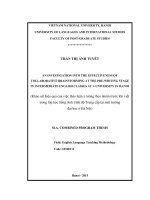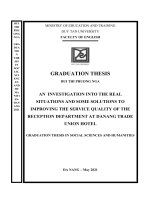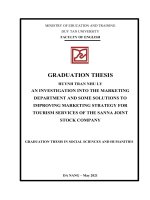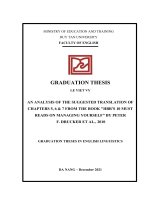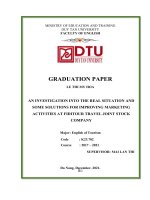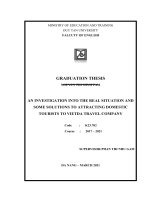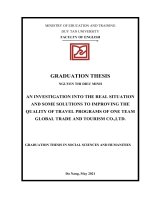AN INVESTIGATION INTO THE REAL SITUATION AND SOME SOLUTIONS TO IMPROVING THE QUALITY OF CUSTOMER SERVICES AT THAI MARKET RESTAURANT
Bạn đang xem bản rút gọn của tài liệu. Xem và tải ngay bản đầy đủ của tài liệu tại đây (2.39 MB, 59 trang )
1
LE
Q
UA
NG
H
OA
NG
DU
NG
–
GR
AD
UA
TI
ON
PA
PE
R
IN
TO
UR
IS
M
202
2
DUY TAN UNIVERSITY
FACULTY OF ENGLISH
LÊ QUANG HOÀNG DUNG
AN INVESTIGATION INTO THE REAL SITUATION AND SOME
SOLUTIONS TO IMPROVING THE QUALITY OF CUSTOMER
Ghi chú: Bìa ngồi
SERVICES AT THAI MARKET RESTAURANT
DA NANG, 2022
2
Ghi chú: Bìa trong
DUY TAN UNIVERSITY
FACULTY OF ENGLISH
GRADUATION PAPER
AN INVESTIGATION INTO THE REAL SITUATION
AND SOME SOLUTIONS TO IMPROVING THE
QUALITY OF CUSTOMER SERVICES AT THAI
MARKET RESTAURANT
Major: English for Tourism and Hospitality
SUPERVISOR
: LÊ HOÀNG PHƯƠNG, M.A
STUDENT
: LÊ QUANG HOÀNG DUNG
CLASS
: K24 NAD6
STUDENT CODE: 24203216135
DA NANG, 2022
3
ACKNOWLEDGEMENTS
My graduation thesis could not successfully complete without the
invaluable help, advice, and encouragement from many teachers in the Faculty
of English and all staff in Thai Market restaurant.
First and foremost, I would like to express my deepest gratitude to all
teachers of Duy Tan University in general and the Faculty of English in
particular, especially Mrs. Le Hoang Phuong, my supervisor. During the writing
thesis process, she gave me helpful suggestions, critical comments, and support
so that I could finish my graduation thesis.
Secondly, I would like to send my thankful words to Thai Market
restaurant and Mr. Le Thai Hoang , who created an opportunity for me to
practice at the restaurant and directly trained during my internship. I will not
have the accurate document in the Hospitality document as well as wonderful
advice to complete this graduation thesis without his enthusiastic help.
Thirdly, allowing me to express my thank to all staff of Thai Market
restaurant, who always shared working experience and provided me with useful
information, document whenever I need.
Last but not least, I also sincerely thank my family, my friends for their
support and encouragement during the process of conducting this study.
Moreover, the shortcomings in this graduation paper are unavoidable.
Therefore, I hope to receive the sympathy from teachers.
Finally, I respectful wish all teachers a lot of health, success in the noble
careers, and wish members of Thai Market restaurant all health, happiness in
their life.
Thank you so much
Sincerely
Le Quang Hoang Dung
4
STATEMENT OF AUTHORSHIP
Except where reference is made in the text of the thesis, this thesis contains
no material published elsewhere or extracted in the whole or in part from a
thesis by which have qualified for or been awarded another degree or diploma.
No other person’s work has been used without due acknowledgement in
the thesis.
This thesis has not been submitted for award of any degree or diploma in
any other tertiary institution.
Danang, May 19th, 2022
Le Quang Hoang Dung
5
ABSTRACT
This graduation thesis begins with investigating on hospitality sector, mainly
focused on real situation of the quality of Customer services for consumers at Thai
Market Restaurant and some solutions to improving them. This case study is
carried out basing on the theoretical background and the practical data. To find the
results, I will gather all of the main related, information about the quality of
customer services at Thai Market Restaurant through my survey, finding and
observation. Based on the information, I will give out some solutions to improving
the quality of customer services for consumers at the restaurant.
I hope my recommendations will help the restaurant to attract more
customers and contribute to the growth of the hospitality industry in Da Nang city.
6
LIST OF ABBREVIATIONS
ACT: Accounting
AM: Area Manager
CEO: Chief Executive Officer
CIT: Corporate Incomes Tax
DIR: Director
HR: Human Resources
IC: Internal Control
IT: Information Technology
MKT: Marketing
PW: Production Warehouse
QC: Quality Control
RM: Restaurant Manager
SS: Supervisor
TN: Training
7
LIST OF TABLES
Table 1: Thai Market Restaurant’s Facilities
Table 2: Standards of the Catering Department in Thai Market restaurant
Table 3: Thai Market Restaurant Business Performance from 2018 to 2021
Table 4: The percentage of customers who made reservations through various
sources in 2020
Table 5: Quality of Serving Customers in 2020
Table 6: Service Attitude of Thai Market restaurant’s service staffs
Table 7: Guest’s Evaluation on Food and Drink
Table 8: Guests’ Evaluation on Facilities
8
LIST OF FIGURES AND DIAGRAMS
Diagram 1. Organizational Structure of Thai Market Company.
Diagram 2. Organization Structure of Catering Department.
Diagram 3. The percentage of customers who made reservations through
various sources in 2020.
9
TABLE OF CONTENTS
CHAPTER 1: INTRODUCTION
1.1 Rationale
1.2 Aims and Objectives
1.3 Scope of the Study
1.4 Methods of the Study
1.5 Organization of the Study
CHAPTER 2: THEORETICAL BACKGROUND
2.1 Hospitality Industry
2.2 Concepts of Restaurant
2.3. Concepts of Restaurant Business
2.3.1. Definition
2.3.2. Classification of Restaurants
2.4. Customer Satisfaction
2.4.1. Definition
2.4.2. The important of customer satisfaction
2.5. Customer Services
CHAPTER 3: CASE DESCRIPTION
3.1 Introduction of the Thai Market Company
3.1.1. A General Overview
3.1.2. Organizational Structure of Thai Market Company
3.1.3. The Functions and Duties of Each Department.
3.1.3.1. Director
3.1.3.2. Chief Executive Officer (CEO)
3.1.3.3. Area Manager
3.1.3.4. Human Recourses
3.1.3.5. Marketing
3.1.3.6. Accounting
3.1.3.7. Training
3.1.3.8. Production Warehouse
3.1.3.9. Information Technology – Internal Control
3.1.3.10. Quality Control
3.1.3.11. Restaurant Manager
3.1.3.12. Shift Supervisor
3.1.3.13. Employees
3.1.4. Services of Thai Market restaurant
3.2. Catering department of Thai Market restaurant
3.2.1. Thai Market Restaurant structure/catering department
3.2.2. The Functions of Catering Department
3.2.2.1. Manager
3.2.2.2. Supervisor
3.2.2.3. Service staff
10
3.2.3. Facilities of the Thai Market restaurant
CHAPTER 4: ANALYSIS AND EVALUATION
4.1. A Current Assessment of Thai Market restaurant
4.1.1. Working hours
4.1.2. Working style
4.1.3. Uniform
4.2. An Evaluation on Thai Market restaurant Business Performance from 2018
to 2021
4.3. Services
4.3.1. Reservations
4.3.2. The Procedure for Serving Food
4.3.3. Attitude of Service
4.3.4. Guests’ Evaluation on Food and Drink
4.3.5. Guests’ Evaluation on Facilities
4.4. Strengths
4.5. Weaknesses
CHAPTER 5: DIFFICULTIES AND SOLUTIONS
5.1. Difficulties
5.1.1. Objective Difficulties
5.1.2. Subjective Difficulties
5.2. Some Solutions to Improving the Service Quality at Thai Market restaurant
5.2.1 Wastage of Food & Quality of Food
5.2.2 Poor Customer Experience and Customer Service
5.2.3 Restaurant Marketing Challenges
5.3. Possibilities of the Suggested Solutions
CHAPTER 6: CONCLUSION AND SUGGESTIONS
6.1 Conclusion
6.2 Suggestions
6.2.1. Suggestions for Duy Tan University
6.2.2. Suggestions for the Faculty of English
6.2.3. Suggestions for the Thai Market company
QUESTIONNAIRE
REFERENCES
11
CHAPTER 1: INTRODUCTION
1.1.
Rationale
In the trend that the world economy is developing rapidly. And tourism is
chosen by many countries as a key economic sector, recognizing the importance
of tourism while also keeping up with the global economy's development trend.
In the world, Vietnam has also identified tourism as a spearhead economy. In
fact, tourism has brought our country a large source of foreign currency, so it is
called a smokeless industry.
More and more tourists come to Vietnam, so to meet the indispensable
needs of tourists, many hotels and restaurants have been built.
In addition to accommodation services, the need for food is one of the
indispensable needs in human life. People's living standards are improving day
by day, requiring a fuller and more diverse response to their dietary needs. A
series of restaurant systems have been born with many different sizes, rich
products to serve a wide range of customers and bring economic efficiency to
businesses in particular and the tourism industry in general.
In the business process of any restaurant, in order to have success and bring
attractiveness to customers, the important factor is the serving staff and the way
the food is prepared. To the role of restaurant staff, they are the people who
directly contact and serve customers, bringing in revenue and profit for the
restaurant.
Thai Market Restaurant commenced operations in the end of 2012 in Da
Nang as the city’s business in the hospitality industry. The restaurant always
wants to provide customers with the best quality of customer services. To
compete with other business restaurants and meet the increasing need of
consumers, Thai Market Restaurant needs to focus on the quality of consumer
cares as well as providing timely solutions to improve it better. That is why I
12
decided to choose the topic “An Investigation into Real Situation and Some
Solutions to Improving the Quality of Customer Services at Thai Market
Restaurant” for my graduation paper.
1.2.
-
Aims and Objectives
Aims
This paper aims to conduct research on the real situation of the quality of
customer services for everyone at Thai Market Restaurant and suggest some
solutions to improve the quality of customer services at the restaurant.
-
Objectives
The purpose of this study is to achieve the following goals:
+ Examining the whole welcome process at Thai Market restaurant in great
detail.
+ Determining the quality customer service’s strengths. Shortcomings,
opportunities, and threats.
+ Making recommendations on ways to improve customer service quality.
Scope of the Study
This investigation focuses only on discussing issues related to the real situation
1.3.
and some solutions to improving the quality of customer services at Thai
Market Restaurant.
1.4.
Methods of the Study
In the process of making this: I use the methods such as:
1.5.
Direct observation of the reception service activities has been carried out
Method of Collection
Method of Description
Method of Analysis
Organization of the Study
Chapter 1: Introduction
Chapter 2: Theoretical background
Chapter 3: Case description
13
Chapter 4: Analysis and evaluation
Chapter 5: Difficulties and solutions
Chapter 6: Conclusions and suggestions
References
Appendix
14
CHAPTER 2: THEORETICAL BACKGROUND
2.1. Hospitality Industry
The hospitality industry is one of the industries that is growing very fast due to
the fast growth of economies that have necessitated the growth of this sector.
Many investors opt to invest in this industry because it is widely known that,
such businesses have considerable profits. Hospitality is the main service sector
in the global economy.
It contains different service industries among which are food service, the
tourism and the hotel sectors. The industry is divided into two parts. These are
the entertainment part of the industry which houses clubs, bars and the
accommodation part that entails public houses, inns, resorts, hotels, hostels
campgrounds, motels and serviced apartments. Restaurants fall under the
category of clubs and bars. Under the same category also fall nightclubs and fast
foods (Barrows & Powers, 2009).
Restaurant industry is a component of the larger hospitality industry. It is the
industry that is changeable in the external environment. For such an industry to
remain relevant and competitive in the market, it has to be very flexible, and
have the diversity to enable it to easily adapt to these changes (Montesano, Lee
and Institute of Southeast Asian Studies, 2011).
2.2. Concepts of Restaurant
Nowadays, each mention of the restaurant will not be unfamiliar to each of us
and each person will feel differently about the restaurant. So what do we think
about a restaurant? There will be many different interpretations and definitions
of restaurants for sure. The word restaurant covers a broad range of food service
operations. The term comes from the French word restaurant, meaning “restorer
of energy.” The term was used as early as the mid-1700s to describe public
places that offered soup and bread. Today, any public place that specializes in
15
the sale of prepared food for consumption on- or off-premise can be described
as a restaurant (Barrows, Powers & Reynolds, 2012, p.68)
Restaurant now becomes a popular food and beverage business in the world,
ensuring the quality of the food and services for the food and beverage business,
meeting some requirements for enjoying, relaxation and dining.
2.3. Concepts of Restaurant Business
2.3.1. Definition
According to Vietnam National Administration of Tourism and Ministry of
Commerce (1986), a restaurant is a commercial institution that trades in highquality food and beverages and has a set capital level based on the requirements
for each type of business.
2.3.2. Classification of Restaurants
Ancient Indian History & Archaeology, Vikram University, Ujjain (n.d)
indicated all restaurants can be classified according to a set of social parameters
defined as polar opposites: high or low, cheap or dear, familiar or exotic, formal
or informal, and so forth. Any restaurant will be relatively high or low in style
and price, familiar or exotic in the cuisine it offers to different kinds of
customers, and so on. Context is as important as the style and form:
-
Ethnic restaurants specialize in ethnic or national cuisines. For example,
-
Indian cousin, Chinese cousin etc.
Fast food restaurants emphasize speed of service. Operations range from
small-scale street vendors with food carts to multibillion-dollar
corporations like McDonald's and Burger King. Food is ordered not from
the table, but from a front counter (or in some cases, using an electronic
terminal). Diners typically then carry their own food from the counter to a
table of their choosing, and afterward dispose of any waste from their
trays. Fast food restaurants are known in the restaurant industry as QSRs
or quick-service restaurants
16
-
A casual dining restaurant (or sit - down restaurant) is a restaurant that
serves moderately priced food in a casual atmosphere. Except for buffetstyle restaurants, casual dining restaurants typically provide table service.
Casual dining comprises a market segment between fast food
establishments and fine-dining restaurants. Casual dining restaurants
often have a full bar with separate bar staff, a full beer menu and a limited
wine menu. They are frequently, but not necessarily, part of a wider
-
chain.
Premium casual restaurants originate from Western Canada. Premium
casual restaurants are described as upscale fast casual. Similarly to casual
dining, they typically feature a dining room section and a lounge section
with multiple screens. They are typically found downtown or in shopping
districts. Premium casual restaurants carry a wide range of menu options
-
including burgers, steaks, seafood, pizza, pasta and Asian foods.
Family style restaurants are a type of casual dining restaurants where
food is often served on platters and the diners serve themselves. It can
-
also be used to describe family-friendly diners or casual restaurants.
Fine dining restaurants are full-service restaurants with specific dedicated
meal courses. Décor of such restaurants features higher-quality materials,
with establishments having certain rules of dining which visitors are
generally expected to follow, sometimes including a dress code. Fine
dining establishments are sometimes called white - tablecloth restaurants,
because they traditionally featured table service by servers, at tables
covered by white - tablecloths. The tablecloths came to symbolize the
experience. The use of white tablecloths eventually became less
fashionable, but the service and upscale ambiance remained.
2.4. Customer Satisfaction
Every business relies on customer satisfaction. Profitability, reputation, sales,
service, and image all rely on customers; as a result, they must always be treated
17
with respect. In today's market, achieving a balance between customer
satisfaction and company profitability is critical to any firm's success. Customer
satisfaction is defined in a variety of ways by many authors and scientists. The
most prevalent definitions of customer satisfaction will be introduced in the
next paragraph.
2.4.1. Definition
Kotler and Keller gave the most comprehensive definition of customer
satisfaction. They defined it as follows: “person's feeling of pleasure or
disappointment which resulted from comparing a product's perceived
performance or outcome against his/her expectations” (Kotler and Keller 2006,
144.)
According to Rai (Rai 2008, 7.), the formula for customer satisfaction is the
following: customer satisfaction equals customer perception of the service
received minus customer expectation of the customer service. Referring to this
method, the conclusion is that if customer’s perception of the service exceeds
customer’s expectation, then a client stays satisfied as well as the opposite; if
customer’s perception is less than customer’s expectations, then a client gets
dissatisfied.
Tse and Wilton identified customer satisfaction as ‘’the consumer’s response to
the evaluation of the perceived discrepancy between prior expectations (or some
norm of performance) and the actual performance of the product as perceived
after its consumption’’. (Tse & Wilton 1988, 204.)
According to Gerson, customer satisfaction is a customer’s perception of the
expectations that have been or have been not met. The buyer obtains the product
or service and expects it to work well. If it does, the customer is satisfied if it is
not, the customer is dissatisfied. (Gerson 1993, 5.)
2.4.2. The important of customer satisfaction
18
Customer satisfaction can be a fatal factor that affects any source of
business and company performance .According to LaBarbera and Mazursky
(1983), “satisfaction influences repurchase intentions whereas dissatisfaction
has
been
seen
as
a
primary
reason
for
customer
defection
or
discontinuation of purchase”. When achieved customer satisfaction it can lead
to a lot of advantages. According
to
Jochen Wirtz (2003)
customer
satisfaction may lead to customer: customer are more likely to come back to
repurchase product or services , and generated customer loyalty as well as they
will
introduce
the product
to
other
people
surround
them,
as
a
consequence this will lead to an increase on long term profitability of the
company
2.5. Customer Services
Customer service is a system of activities that comprises customer
support systems, complaint processing, speed of complaint processing, ease of
reporting complaint and friendliness when reporting complaint (Kim, Park
and Jeong, 2004). Customer services are the opportunities for telecom
service providers that are added to mobile network other than voice services in
which contents are either self produced by service provider or provided through
strategic compliance with service provider (Kuo, Wu and Deng, 2009). The
improved customer services are the focal point of the telecom service providers
for social as well as for economic reasons. From a social point of view, services
should be available to the customers on reasonable terms. As far as economic
factor is concerned, services should satisfy the needs of the customers (Turel
and Serenko, 2006; Melody, 1997).
For
developing
satisfaction
among
customers,
the
telecom
service
providers need to be extra careful for the customer services they provide.
Satisfaction of customer is determined by his evaluation of service provided by
a brand (Gustafsson, Johnson and Roos, 2005). The study of Ahn, Han and Lee
19
(2006) shows that when the customers, do not get their complaints
considered properly, they start looking for other brands. It happens
because either the customer service centers do not handle the complaints or
the customers are not able to address them properly. Sometimes, telecom
service providers take considerably longer time to resolve the problems like
network coverage or call quality, the customers do not wait for long and
hence they lose satisfaction with that particular brand (Ahn, Han and Lee,
2006).
Furthermore, the friendly attitude and courteous behavior of the service
workers at service firms leaves a positive impression on the customer
which lead towards customer satisfaction (Soderlund and Rosengren, 2008).
On the other hand, if a telecom service provider lacks in providing services
(call drops) to its customers it experiences customer churn. Kim, Park
and Jeong (2004) argued that service provider should provide customer
oriented services in order to heighten up customer satisfaction. It was also
found that the customers get satisfied to a brand more if they get all the needed
services accumulated in that very brand (Ahn, Han and Lee, 2006).
20
CHAPTER 3: CASE DESCRIPTION
3.1 Introduction of the Thai Market Company.
3.1.1. A General Overview
Contact information:
- Address: + 48 Thai Phien - Phuoc Ninh - Hai Chau - Da Nang
- Phone number: (+84) 2363888163
- Fax: (+84) 2363888163
- Email:
- Website:
21
Thai Market Company is a system of Thai Market - a chain of restaurants
specializing in famous Thai dishes, born in 2012 in Da Nang. Until now, the
Thai market chain has more than 10 restaurants serving customers to eat and
learn about Thai cuisine.
History:
- 2012: Indochina food court – Da Nang
- 2013: 04 Tran Quoc Toan – Da Nang
- 2014: 17 Le Hong Phong – Da Nang
- 2015: 62 Phan Chu Trinh - Hoi An
- 2016: 46 Thai Phien – Da Nang
- 2018: 183 Nguyen Van Thoai – Da Nang
- 2019: Ba Na and Binh Minh 5 – Da Nang
- 2020: Pi Thai (Thai noodle soup) and Morfai (Thai Hot Pot Buffet) – 17 Le
Hong Phong – Da Nang
-2021: 95 Cao Thang – Ho Chi Minh and 112 Trung Hoa – Ha Noi
Today's success of the restaurant chain is a process of inspiration from the brand
owner and the collective work of Thai Market. Mr. Le Thai Hoang, the founder
of the restaurant chain, spent a lot of time traveling through most of Thailand to
enjoy and learn how to cook delicious food. With the passion for food and the
ability to cook formed from a young age, it was not too difficult for him to find
delicious recipes and recipes from Udon Thani, Bangkok, Chiang Mai, Phuket
or Pattaya, etc.
22
3.1.2. Organizational Structure of Thai Market Company
FOUNDER-DIR
CEO
AM
HR
RM
MKT
ACT
TN
PW
IT-IC
SS
EMPLOYEES
Diagram 1 : Organizational Structure of Thai Market Company
3.1.3. The Functions and Duties of Each Department.
QC
23
With almost a decade of experience, Thai Market Company is not only a
reputable restaurant, but also a very successful and skilled organizer. To
contribute to the company's growth, each department works and creates
continuously in order to provide the highest quality products to clients. Each
department's duties will be listed in this section.
3.1.3.1. Director
A Director is the person elected by the shareholders to direct, conduct, manage
or supervise the affairs of the company. Branch manager is also the joint
operations planner as well as behalf of the company negotiate with a partner.
3.1.3.2. Chief Executive Officer ( CEO)
An CEO is responsible for managing a company's overall operations. This may
include delegating and directing agendas, driving profitability, managing
company organizational structure, strategy, and communicating with the board.
3.1.3.3. Area Manager
An area manager has operational and financial responsibility for a defined
region or territory. Their duties include providing training and development for
staff, ensuring quality consistency across the region and increasing sales and
profitability in their region.
3.1.3.4. Human Recourses
A human resources manager plan, coordinate, and direct the administrative
functions of an organization. They oversee the recruiting, interviewing, and
hiring of new staff; consult with top executives on strategic planning; and serve
as a link between an organization's management and its employees.
3.1.3.5. Marketing
24
A marketer is responsible for developing and executing strategies to promote
brands, products and services, maximizing profits for the company. They
monitor trends and develop pricing strategies and advertising campaigns.
3.1.3.6. Accounting
An accountant is a professional who handles the bookkeeping and prepares
financial documents like profit-and-loss statements, balance sheets and more.
They perform audits of your books, prepare reports for tax purposes, and handle
all the financial information that's part of running your business.
3.1.3.7. Training
A restaurant trainer instructs workers using suitable instruction techniques. For
example, when a restaurant's supervisors lack adequate job knowledge, trainers
may schedule classes and prepare training manuals on sanitation, nutrition,
record-keeping and food preparation.
3.1.3.8. Production Warehouse
A warehouse production worker is the person who will check the food, raw
materials, and goods, know how to store all kinds of goods and keep them at the
correct temperature and take a thorough inventory of your foods.
3.1.3.9. Information Technology – Internal Control
An internal controller is the person who checks and monitors the granting of
permission to use applications, receives requests, handles problems during use,
software, computer operation, hardware systems ...
3.1.3.10. Quality Control
25
A quality controller is an important part of the quality management process, the
work related to the inspection, control and evaluation of the quality of products
and goods before carrying out the packaging process, granting circulation
permission, widely on the market.
3.1.3.11. Restaurant Manager
The system has 7 restaurants, so there will be 7 restaurant managers and their
functions are to recruit and train staff, manage the entire restaurant and handle
situations that occur at the restaurant.
3.1.3.12. Shift Supervisor
7 restaurants also have 7 supervisors who are responsible for assigning,
allocating jobs to employees, tracking shifts, dividing shifts, and allocating time
for employees.
3.1.3.13. Employees
On average, each restaurant will have two cashiers. The kitchen has ten
individuals and the service serves 11 people. Throughout the dining process,
waiters and cashiers are in direct contact with guests and serve them. The
person in charge of the kitchen is the one who prepares the meals for the
customers.
3.1.4. Services of Thai Market restaurant
* Food service


